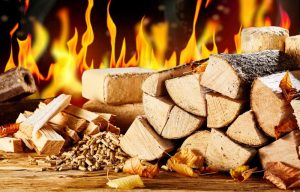Wood has been a primary source of fuel for centuries, providing warmth, energy, and even cooking capabilities. However, not all wood burns the same—some types produce more heat, burn cleaner, and release fewer harmful wood chemicals than others. Choosing the right wood fuel can significantly impact efficiency, environmental sustainability, and indoor air quality.
In this comprehensive guide, we’ll explore the five best wood fuels for heating, examining their energy output, burning characteristics, and the chemical compounds they release. Whether you’re using a fireplace, wood stove, or outdoor boiler, selecting the right wood can make all the difference.

1. Oak – The King of Firewood
Why Oak is a Top Wood Fuel
Oak is widely regarded as one of the best firewood choices due to its high density and slow-burning properties. It produces a long-lasting, consistent heat, making it ideal for overnight burns in wood stoves.
Heat Output and Efficiency
-
BTU Rating: 24-28 million BTUs per cord
-
Burning Characteristics: Slow and steady burn with minimal sparking
-
Seasoning Time: Requires 1-2 years to dry properly
Wood Chemicals and Emissions
Oak contains lignin, cellulose, and tannins, which contribute to its dense structure. When properly seasoned, it emits fewer volatile organic compounds (VOCs) than softer woods, reducing creosote buildup in chimneys.
Best Uses
-
Primary heating source for homes
-
Long overnight burns in wood stoves
2. Hickory – The High-Energy Hardwood
Why Hickory is Exceptional
Hickory is another premium hardwood known for its intense heat output and pleasant aroma. It’s often used for smoking meats due to its rich flavor, but it’s also an excellent firewood choice.
Heat Output and Efficiency
-
BTU Rating: 27-28 million BTUs per cord
-
Burning Characteristics: Burns hot and fast, with little residue
-
Seasoning Time: 1-2 years
Wood Chemicals and Emissions
Hickory contains high levels of lignin, which contributes to its high energy density. However, if not fully dried, it can produce more smoke due to residual moisture and sap-related compounds.
Best Uses
-
High-efficiency wood stoves
-
Outdoor cooking and smoking
3. Maple – A Reliable and Versatile Firewood
Why Maple is a Great Choice
Maple is a well-balanced hardwood that offers good heat output and easy splitting. It’s less dense than oak or hickory but still outperforms most softwoods.
Heat Output and Efficiency
-
BTU Rating: 18-25 million BTUs per cord (varies by species)
-
Burning Characteristics: Steady flame with moderate burn time
-
Seasoning Time: 6-12 months
Wood Chemicals and Emissions
Maple contains cellulose and hemicellulose, which break down efficiently when burned. It produces minimal creosote compared to resinous softwoods like pine.
Best Uses
-
Mixed burning with other hardwoods
-
Fireplaces and smaller wood stoves
4. Ash – The Low-Maintenance Firewood
Why Ash Stands Out
Ash is prized for its low moisture content, meaning it can be burned even when not fully seasoned (though seasoning is still recommended). It splits easily and produces a clean flame.
Heat Output and Efficiency
-
BTU Rating: 20-24 million BTUs per cord
-
Burning Characteristics: Lights quickly and burns steadily
-
Seasoning Time: 6-12 months (can burn “green” in emergencies)
Wood Chemicals and Emissions
Ash has low resin content, reducing smoke and creosote formation. Its simple wood chemistry makes it one of the cleanest-burning hardwoods.
Best Uses
-
Quick fires and kindling
-
Mixed fuel in wood boilers
5. Birch – The Fast-Burning Beauty
Why Birch is Unique
Birch is known for its attractive bark and quick ignition, making it great for starting fires. While it burns faster than other hardwoods, it provides strong, radiant heat.
Heat Output and Efficiency
-
BTU Rating: 20-22 million BTUs per cord
-
Burning Characteristics: Fast burn with bright flames
-
Seasoning Time: 6-12 months
Wood Chemicals and Emissions
Birch bark contains betulin, a natural compound that gives it a distinct scent. However, it can produce more volatile organic compounds (VOCs) than denser hardwoods.
Best Uses
-
Fireplace ambiance
-
Kindling and quick heat bursts
Wood Chemicals and Environmental Impact
All wood releases chemical compounds when burned, including:
-
Carbon monoxide (CO) – A byproduct of incomplete combustion
-
Particulate matter (PM2.5) – Tiny particles that affect air quality
-
Volatile organic compounds (VOCs) – Released from resins and sap
Hardwoods generally produce fewer emissions than softwoods because they contain less resin and more dense fibers, leading to cleaner combustion.
Tips for Cleaner Burning
-
Season wood properly (moisture content below 20%)
-
Avoid treated or painted wood (releases toxic chemicals)
-
Use EPA-certified stoves for better efficiency
Conclusion: Choosing the Best Wood Fuel
The five best wood fuels—Oak, Hickory, Maple, Ash, and Birch—each offer unique benefits in terms of heat output, burn time, and wood chemical emissions. For the most efficient and sustainable heating, hardwoods like oak and hickory are the top choices, while birch and ash provide excellent supplemental options.
By understanding the chemical properties and burning characteristics of different woods, you can maximize heat efficiency, reduce environmental impact, and enjoy a cleaner, longer-lasting fire. Whether you’re heating your home or cooking over an open flame, selecting the right wood fuel makes all the difference.
Would you like recommendations for wood-burning appliances to pair with these fuels? Let us know in the comments!
